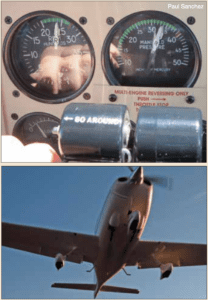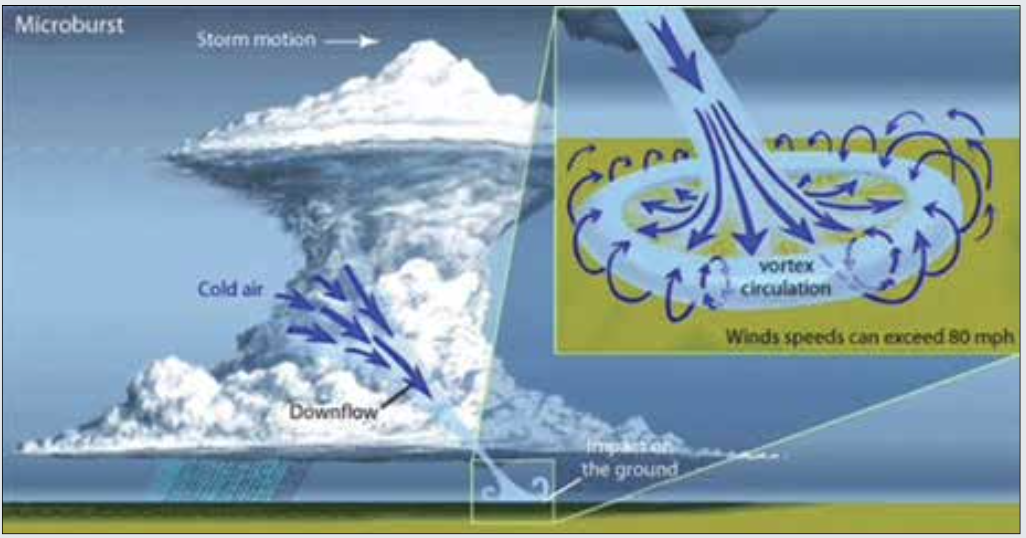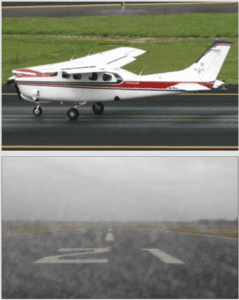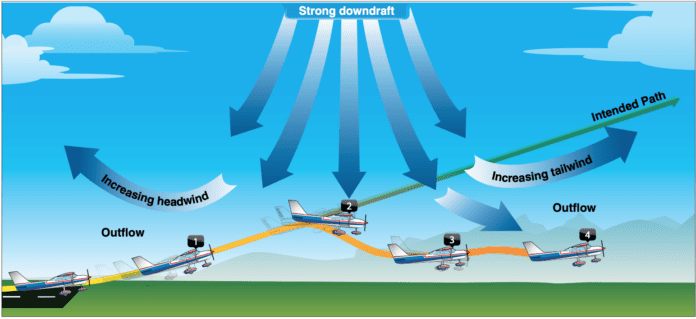Inspiration struck me for this topic while flying recently. I would not quite call it complacency, but flying on gusty days definitely feels routine. For example, it would not deter me if I saw a local airport reporting LLWS (low level windshear) +/-5 knots by a Skyhawk. In fact, a local airport is famous for reporting LLWS perpetually on gusty days. It is obviously a consideration, but not something I would cancel a flight over.
So when I was out flying, the moderately gusty weather did not raise any flags. We had flown into the same airport about three hours earlier with nothing more than light turbulence on the approach. The winds were about 30 degrees off the runway, at 10 or so knots, with gusts into the mid-teens. Again, nothing that would set off any alarm bells. We added the appropriate airspeed buffer—half the gust value—and continued the approach.
The only odd thing I noticed was an exceptionally low groundspeed. The surface winds would have provided roughly 10 knots of headwind, but we were covering the ground 30 to 35 knots more slowly than the advertised winds should have dictated. This should have raised more flags, but that is hindsight for you. The approach was stable. Bumpy, but stable. Right up until about 50 feet above the runway.
I’m not sure if we felt the sink rate increase or if we saw the airspeed start to drop, or both. Either way, we both raced to get full power in. Luckily we did, because even with quick action we had one of the firmest touchdowns and most enthusiastic bounces I have experienced. Initially, the event felt undetectable. After some analysis and research, I think there were signs, albeit subtle ones. That’s what this is all about, right? Learning as we gain experience and becoming better aviators?

Obviously, the best recovery method is never having entered windshear at all. Most causes of windshear are thunderstorms or related to frontal weather. That being said, many cases of windshear have come immediately after another aircraft reported a smooth approach.
There may be a time where you experience windshear and require an escape maneuver. The Flight Safety Foundation’s Approach and Landing Accident Reduction (ALAR) Tool Kit has a fantastic chapter on windshear and covers the escape technique. It is designed mostly for high-performance aircraft, but it is worth reading. Below, I have summarized the procedure and made an attempt to streamline it for all aircraft.
- Add full power/maximum thrust.
- Pitch up 10-20 degrees, or as much as your aircraft allows. Respect any stall indications and reduce the angle of attack if any occur.
- Do not change any configuration (gear/flaps) until completely out of the windshear.
- Level the wings to maximize climb gradient, unless a turn is required for obstacle clearance.
- Continue a normal climb profile once clear of the windshear.
Once clear, do your fellow aviators a favor and shoot out a Pirep. It could potentially save someone’s life!
Paul Sanchez
WHAT IS WINDSHEAR?
“Wind shear is a change in wind speed and/or direction over a short distance. It can occur either horizontally or vertically and is most often associated with strong temperature inversions or density gradients. Wind shear can occur at high or low altitude.” This definition is straight from the horse’s mouth: Wind Shear, FAA publication P-8740-40, which identifies four common sources of the phenomenon. They are:
Frontal Wind Shear
There are two indications a front may have windshear associated with it. First, the temperature difference across the front at the surface is greater than 10 degrees F (five degrees C). Second, the front is moving at least 30 knots.
The first one is a lot easier to judge on your own. Please write in if you aware of an easy way to determine frontal speed, but I cannot find one. Just another good reason to give your weather briefer a call.
Thunderstorms
Thunderstorms cause all sorts of headaches. Other than actually flying through one, windshear is the biggest hazard associated with thunderstorms. Initially, you have first-gust hazards, which are the rapid changes in wind before a thunderstorm arrives. This typically extends from the surface up to about 6500 feet agl. As the storm dissipates, strong downdrafts can occur. There is no use paraphrasing, so here is the scoop on how dangerous this can be, from the FAA publication Wind Shear, cited earlier:
“Gusty winds are associated with mature thunderstorms and are the result of large downdrafts striking the ground and spreading out horizontally. These winds can change direction by as much as 180 degrees and reach velocities of 100 knots as far as 10 miles ahead of the storm. The gust wind speed may increase by as much as 50 percent between the surface and 1,500 feet, with most of the increase occurring in the first 150 feet. The implications for a shear on approach in such a case are obvious.
“The other wind problem mentioned previously, the downburst, is also downdraft related. It is an extremely intense, localized downdraft from a thunderstorm. This downdraft exceeds 720-feet-per-minute vertical velocity at 300 feet AGL. The power of the downburst can actually exceed aircraft climb capabilities, not only those of light aircraft, but, as is documented in one case, even a high-performance Air Force jet.
“The downburst is usually much closer to the thunderstorm than the first gust, but there is no absolutely reliable way to predict the occurrence. One clue is the presence of dust clouds, roll clouds, or intense rainfall. It would be best to avoid such areas.”
Temperature Inversion
Temperature inversion windshear occurs when overnight cooling creates a temperature inversion at low altitudes. Once that inversion meets higher wind speeds from the low-level jet stream, significant windshear can occur. Even as the inversion dissipates, the shear plane can drift closer to the ground. In some areas of the Southwestern U.S., this can cause a 90-degree shift and a 20-30 knot increase in surface winds in a matter of minutes.
Surface Obstructions
Buildings, mountains and any other surface obstructions can cause localized windshear on approach. This type of windshear can be expected any time surface obstructions are present and there are strong surface winds. The challenge is that windshear is difficult or impossible to predict.

A microburst is the most hazardous form of windshear. Delta Air Lines Flight 191, a Lockheed L-1011, crashed in DFW in 1985 as a result of flying into a microburst on approach, which is a case study worth reading. That accident, and several others before it also linked to the phenomenon, led to enormous improvement in windshear detection and avoidance. Only approximately five percent of thunderstorms produce a microburst, but they can occur in any convective conditions. The hazard associated with a microburst, severe downdrafts, are typically only a few hundred to 3000 feet across. But if you and your airplane are within that area, things could get sporty.
Microbursts are usually visually identified by precipitation, ranging anywhere from heavy precipitation to light virga. An additional sign of a potential microburst is a rapidly increasing headwind. This is not necessarily always the case, due to asymmetric formation of the microburst, as depicted by the inset in the image above.
I could go on describing the hazards associated with a microburst, but I think the FAA does a fine job in AC 00-54: Pilot Windshear Guide:“
- IT IS VITAL TO RECOGNIZE THAT SOME MICROBURSTS CANNOT BE SUCCESSFULLY ESCAPED WITH ANY KNOWN TECHNIQUES! Note that even windshears which were within the capabilities of the airplane have caused accidents.”
The AC goes on to note that Andrews Air Force Base in 1983 experienced a windshear event that “indicated headwind/tailwind differential velocities near 200 knots.”
The capitalization and exclamation point in the quote above are not some flavor I added; that’s right from the AC’s text. That’s one way you know the FAA means business.
RECOGNITION
The majority of windshear risk is on landing. Windshear can occur at any altitude, but at cruise there is usually adequate airspeed and altitude to recover. Preflight weather checks are the first step in recognizing windshear. Gusty conditions and frontal activity can be indicators of windshear potential, but the most accurate information comes from pilot reports. Just as when analyzing any other Pirep, aircraft type should be factored in. Plus or minus 10 knots should be considered differently when reported by a C172 versus a B737.
The other signs can be more subtle, especially initially. Thoughtful flying can key one into this. For example, if you are flying an ILS, you should have a rough idea of a typical power setting. A sign of incipient windshear is increased performance. If there is a sudden increase in headwind, a lower power setting will be required to maintain glidepath.
When this happened to me, it was not a gusty day nor was LLWS reported. I just had that little voice in my head that said, “Something does not look right.” At around 1000 feet agl, the headwind sheared off to a tailwind and a substantial amount of power was required to remain on the glidepath. Luckily this occurred at a high enough altitude and with enough airspeed that recovery was a non-issue.
Other than power settings, observing airspeed is critical to recognizing windshear. Obviously if a rapid airspeed drop occurs, immediate action is required. There can be clues before this, however. For example, if your aircraft indicates groundspeed, this can be a great tool to detect windshear early. Rapidly increasing or decreasing groundspeed should throw yellow flags, at a minimum. It is easy to overlook increasing speed, but it’s often an early indicator for windshear.
Know your expected headwind component (roughly) and keep an eye on the windsock. If the winds on the surface are 15 knots, and the winds aloft at 3000 agl are 30 knots, that 15 knots will drop off at some point. That doesn’t sound so bad, but what if the winds aloft are 70 knots and the surface winds are eight?
WHAT SPEED TO FLY?
The normal rule of thumb is adding half the gust factor to your approach speed. A mentor of mine taught me if windshear was reported in the area, he would use the groundspeed and maintain an airspeed that keeps the groundspeed where it’s supposed to be.
For example, let’s say the surface winds were at 10 knots, straight down the runway. Your approach speed is 90 knots. Your expected groundspeed should be around 80. Instead of 80, you look at the groundspeed and it is indicating 60 knots. In this case, he would add 20 knots to the approach speed, until the groundspeed was around 80. When the performance does fall off, there will be adequate speed to recover.
As with many threat management strategies, there can be downsides. If the performance does not decrease, you may end up fast. Therefore, it is critical to be fastidious with landing in the touchdown zone and going around if a landing doesn’t occur before overflying it. I would rather carry the speed in situations of low-level windshear and occasionally go around than have one instance where windshear forces a landing short of the runway.

I will admit, most of the discussion of this article is based on windshear during approach. Most of my experience with dicey LLWS was on approach, but there is another phase of flight where the aircraft is slow and close to the ground: takeoff. The first step is recognizing and briefing the threat. Choose the most favorable runway, considering wind, gradient and length. If all else is equal, consider the departure with the most minimal obstructions. In gusty conditions, it is important to ensure the aircraft is actually at rotation speed before adding backpressure. I have seen an aircraft reach VR, and then subsequently lose 10 knots. This can delay rotation, increase takeoff total distance and potentially prevent obstacle clearance.
The escape maneuvers for windshear on takeoff and windshear on approach are similar. Full power, pitch for max performance, keep the configuration. If you have runway in front of you and cannot rotate (or end up forced back down to the runway) with stopping distance remaining, abort the takeoff. Once airborne, there is the same tradeoff as on approach. Keeping the wings level will result in the best climb performance, but obstacles must be considered.
And remember that if windshear is reported, suspected or conditions are ripe and you just have a bad feeling, you always have another option: Don’t take off.
AVOID, REJECT, RECOVER
As noted, the best windshear strategy is avoidance: If you’re not where the windshear is, you won’t be affected. Solutions include diverting or staying in the FBO lounge until it blows over. Rejecting approaches or takeoffs in gusty weather or when storms are about is your next line of defense. In the event, maximum performance is needed from the pilot—that’s you—and from the airplane. Recoveries are relatively easy to practice, especially in training, when someone else decides you must go around.
Ryan Motte is a Massachusetts-based Part 135 pilot, flight instructor and check airman. He moonlights as Director of Safety when he isn’t flying.




